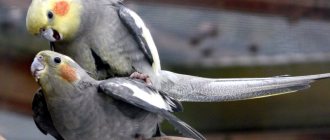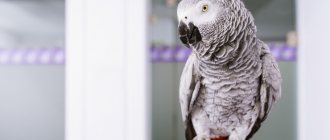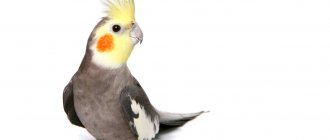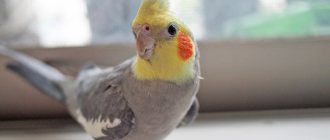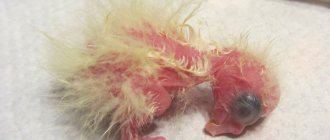Scientists insist that colorful pets inhabited the Australian continent 5 million years ago. Despite such a long stay on earth, evolution has practically not affected this species. Yes, birds can perfectly imitate human sounds and pronounce dozens of words, turn their heads 180 degrees and see the world around them in color, but all this will come later. In the meantime, budgerigar chicks are born helpless and blind. Parents selflessly care for their babies, but sometimes situations arise when they simply cannot do without human intervention.
How chicks are born
Wild birds breed throughout the year, as they live in warm Australia. They lay eggs in hollows or on tree branches. If the wavy animals live at home, then the owner must provide them with some help. To do this, a nest or house is created where the female can organize egg-laying. It is advisable to carry out the process in the summer, when there is long daylight.
If a trusting relationship has been established between the birds, then after installing a nesting house inside the cage, the wavy birds will immediately begin arranging it.
To create bedding, sawdust is usually used, previously cleared of debris and sprinkled with chamomile flowers. Next, the mating games of parrots begin, so they prefer to dance, kiss and sing a lot. It is advisable that both birds be more than 1.5 years old, otherwise the chicks may turn out sick and premature, and sometimes even be born dead.
Did your parrots have chicks?
Yes No
Peculiarities of the birth of wavy plants include:
- approximately 20 days after mating, the female lays eggs, which she incubates for the next 20 days;
- The bird usually lays from 4 to 12 eggs;
- each new egg appears every other day;
- the chicks hatch gradually, and about 12 days can pass between the first-born and the last chick;
- in the upper part of the beak there is a special tooth that allows them to break through the shell;
- pecking is available only to birds that have formed correctly and received enough warmth from the mother;
- the female often helps the chicks by independently breaking through the dense shell, so during this period of time the bird needs a sufficient amount of calcium.
Newly born birds are blind, naked and weak, therefore they are completely dependent on the mother.
The owner of the wavy birds can provide some support to the new chicks. To do this, you need to maintain an optimal microclimate in the room, which consists of air humidity within 65%, as well as a temperature of 22 degrees. If the house is too dry, the special film on the inside of the egg will dry out and envelop the chicks, which will simply suffocate.
Conditions for reproduction
It is advisable for a breeder who decides to breed budgerigars to have several pairs. This will allow, in case of possible problems with the chicks or clutch, to save the offspring and preserve the health of the adults.
Right to breed
Breeding budgerigars at home is not regulated by law; anyone can do it. But to officially register his activities, the breeder must have a license, which is issued by the Society of Bird Lovers. A person needs to confirm that he has knowledge about the breeding and maintenance of budgerigars.
It is the responsibility of veterinarians to check birds for psittacosis. This viral infection can infect not only animals and birds, but also humans. If the test does not reveal this disease, the owner receives official permission for breeding. He is given permanent rings containing information about the breeder, the serial number of his bird, the date and time of registration. During disease outbreaks, this makes it easier to track the location of parrots.
Choosing the right pair
To get healthy offspring, you need to organize the correct selection of a pair of wavy birds. They must be from different parents to prevent the development of genetic diseases in the chicks. How to understand that a male and a female are suitable for each other?
Both parrots should be healthy, active and well-fed. Weak or elderly birds often lay unfertilized eggs. Puberty of females occurs in the second year of life. In males, this period begins a little earlier, from ten months of age. The peak of fertility in wavy birds is observed at the age of 2–4 years. Although parrots breed up to 10 years old.
You might be interested in: Where do parrots live: habitat of popular species of parrots
This is interesting! A budgerigar remains attached to its partner for life. Without mutual sympathy, reproduction does not occur.
Suitable period for breeding
The optimal time for breeding wavy plants at home is the summer months, from June to September. This is the part of the year when parrots get enough sunlight and vitamins. In other periods, they may be weakened due to a deficiency of substances necessary for the body. And this can affect the health of the offspring.
If breeding of parrots is planned for the winter or spring months, the birds must be provided with enhanced nutrition with fresh herbs. At least 14 hours of daylight are required; illumination with a special lamp is allowed. The air temperature must be at least 23 degrees.
Parrot mating process
What conditions need to be created
In addition to selecting a pair, the breeder should think about creating conditions for reproduction. To do this, you need to choose a cage that is suitable in size for the birds. The size of the housing for one pair of wavy plants is 80 cm in length, 40 cm in height and 35 cm in width. If one cell contains several pairs, then these dimensions should be larger.
Females need houses with nests where they can hatch their offspring. When the parrot begins to lay eggs, the cage is placed in a quiet corner so that the bird is not disturbed. The room temperature must be maintained at least 20 degrees. At the same time, heat and stuffiness should not be allowed, as this poses a threat to the embryos.
Feeding parrots during the breeding season
The budgerigar's menu includes grains and seeds, as well as fruits and vegetables.
To stimulate the sexual instinct, the diet should contain the following foods:
- low-fat cottage cheese;
- greenery;
- sprouted grains;
- egg white;
- special mineral supplements.
When a female parrot lays eggs, she requires an increased diet. Products high in vitamin E are very useful. Experienced breeders advise feeding their pets a mixture of cottage cheese, eggs, carrots and sprouted grains.
You might be interested in: How to choose a budgie: preparation, choice of bird, adaptation
It is important to know! Obese or underweight birds are not suitable for breeding. The pair must be fattened before breeding, but not excessively
Appearance
They do not have an attractive appearance, since the birds are born completely naked and blind. They cannot move independently and also weigh only 1 gram. But after about three days their weight reaches 5 grams. They gain weight very quickly, and literally after 25 days they are practically no different in appearance from their adult parents.
Other features of newborn chicks include:
- they may have a few fluffs on their backs, but usually they are born completely naked;
- they are deaf and blind, so they cannot eat or move independently;
- they have an overly large head and long neck, as well as thin legs.
In the first days, the chicks just lie down. The female feeds them ground food from her crop.
In the photo there is a budgerigar chick:
Arranging the nest and keeping it clean
Parrot chicks should be protected from hypothermia. In the wild, mothers warm them under their wings, but if this is not done, then organize the warmth yourself. This will be provided by a heating pad with warm water and a 60 W incandescent lamp. Comfortable conditions for chicks in the first days of life are 36 degrees. It is gradually reduced to 30-32 degrees, starting from three weeks of age - to 24 degrees. Three-week-old chicks are already beginning to fledge; thermoregulation becomes like that of adult birds, so they do not need additional insulation.
The nest of two-week-old babies will need to be thoroughly cleaned. During this period, the chicks are placed in an insulated box. Thoroughly clean all dirt and remove debris. Work quickly to keep the chicks from freezing. The crumbs themselves also need to be examined and, if necessary, cleaned of food debris. Pay special attention to the paws. If a lot of dirt sticks to them, there is a risk of deformation during growth. Heat the water and carefully clean the chicks.
Is human care required?
The most optimal care is provided by the female, who protects and protects her offspring. She tries to pay attention to each chick, regardless of the number of birds. But sometimes babies need human help. For example, if a bird refuses its offspring for various reasons, then the babies can be fed artificially with special food, for which a special probe is used.
But usually the best help lies in nutritious and high-quality nutrition for the mother. Therefore, it is necessary to purchase a balanced grain mixture, as well as treat the female with vitamin supplements, minerals and fresh vegetables and fruits. It is important to regularly maintain optimal home hygiene and avoid excessive reduction in temperature or humidity.
Why do budgerigar chicks die?
The most common reason is genetic disorders that are beyond our control. If this happens often, and you cannot get offspring from this couple, then it is recommended to change your partner.
What else can cause the death of babies:
- Lack of food.
- The female refuses to feed the chicks, and the owner noticed this late and did not have time to hatch the chicks.
- The chicks lack warmth. Watch the temperature!
- If a person without gloves often touches the babies, the female can peck and pluck them.
- If the chick leaves the nest early, one of the parents may kill it.
- The female is in a hurry to make a new clutch and tries to get rid of the babies.
- The female is still quite young and not agile, so she can accidentally run over the chicks.
In fact, caring for chicks is not that difficult. Look into the nest in time and don’t miss the moment when the birds need your help.
Development by day
To understand how small wavy plants grow and develop, the following stages are taken into account:
- in the first three days the chicks are completely helpless, and they also lack plumage;
- on the sixth day, their egg tooth, which is necessary for breaking the shell, falls off, so from this moment the birds can raise their heads;
- a week after birth, the birds’ neck muscles become stronger, so they can easily hold their heads up, and also gradually open their eyes and try to sit up;
- on the 10th day, their gaze becomes more meaningful, and they also begin to clearly see surrounding objects;
- two weeks after birth, the first feathers appear on the back of the head and wings;
- by the end of the third week, the birds acquire full plumage with a specific color;
- after a month, the birds have an elongated tail, and the owner can determine the sex of each chick;
- after 40 days the birds begin to fly a little.
Wavys develop very quickly after birth. Although a person participates little in this process, he must provide optimal external conditions.
Particular attention is paid to nutrition, since the female not only eats on her own, but also feeds her offspring. Literally a month later the birds are not much different from their parents. The differences are only in the size of the body and plumage.
2 months
So you bought a budgie, brought it home in a special cardboard carrier, where to start? Of course, by choosing a spacious and comfortable cage and its location. For a comfortable stay for one bird, the cage must be no less than 40 x 30 and made from environmentally friendly materials. It is also necessary to purchase a drinking bowl and two feeders for grain mixture and treats. Budgerigars are very clean birds, do not forget to buy a bathing suit. A standard cage is usually equipped with perches, various swings and toys.
You can put sawdust, sand on the tray of the cage, or leave it clean, then it is easy to wash, there is no additional debris. The cage must be secured against the wall, then the bird will feel safe. Place it at eye level to communicate with the parrot, otherwise it will go wild. Beware of drafts, but do not forget that the room should always have clean air and plenty of sunlight, otherwise the budgie will start to get sick.
As soon as you bring the bird home, there should be food and water in the cage. At any pet store you can buy ready-made grain food for parrots; it is better not to introduce complementary foods yet. The bird must adapt to life in its new home. try not to make noise, slam doors, or turn on loud music or TV. All this can provoke nervous stress in a budgie, and then they begin to get sick.
What to feed babies
In order for wavy chicks to develop well, nutritious food is required. In the first few days, the female feeds the babies with special goiter milk .
It is represented by mucous secretions, as well as partially digested food.
Milk contains many vitamins and microelements, as well as protein.
After about 5 days, the female begins to give the chicks denser food, which includes undigested grain, which is previously kept in the bird’s crop for several hours.
Sometimes not only the female, but also the male is engaged in preparing such food, and this situation arises if there are many chicks to feed.
Sometimes birds refuse to care for their offspring. This is due to the presence of infectious diseases, aggression towards chicks or too large a brood. Sometimes the female does not care for the chicks because she is preparing for a new clutch or her husband dies.
Under such conditions, the breeder will have to feed the babies himself, otherwise they will die. If the owner has several pairs, then he can transfer the chicks to a more responsible female, who has her own brood. But if such actions do not give the desired result, then you will have to completely take care of the kids yourself.
The process of artificial feeding involves the use of the following quality food:
- special purchased mixtures intended for chicks of different breeds, but they are high cost, and they are also very difficult to find in Russian pet stores;
- well-cooked porridge from oatmeal, peas or buckwheat, and to increase immunity and accelerate growth it is recommended to add a little beet juice to it;
- a decoction infused with various grains, usually millet or oats are used for this;
- malt obtained from sprouted grains, but it must first be thoroughly cleaned, and it is also mixed with a small amount of boiled chicken egg.
If the chicks are hungry, they scream loudly and also behave restlessly. If a person has to feed babies on his own, he will have to be patient for several weeks. This is due to the fact that the chicks need to be fed once every 2 hours. At night, breaks increase to 4 hours, but you still won’t be able to get a full night’s sleep.
Dry food can be given to chicks only after they begin to move independently and even fly around the cage. To feed small birds, you can use a regular syringe without a needle, on which a rubber tube is placed. You can replace such a device with a regular brush, which is dipped into the porridge or mixture, after which it is transferred to the open beak of the chick.
What vitamins should be given to a parrot?
One of the important elements for the full development of poultry is calcium. It makes up about 1.5% of the bird’s weight and is responsible not only for the formation of bone tissue, but also for blood clotting, proper metabolism, the functioning of the nervous system, fetal development and shell formation.
How well calcium is absorbed depends on a helper vitamin called D3. It regulates the process of calcium absorption in the stomach and controls the production of hormones that help remove excess nutrients. Vitamins for parrots kept in captivity must include D3, because domestic birds most often lack it. This vitamin is produced during sun exposure. Since domestic parrots are practically deprived of this opportunity, they can only get it from special supplements.
Parrots also have an urgent need for vitamin A. This organic substance affects almost all body systems: cardiovascular, digestive, and hormonal. When listing vitamins that are vital for a parrot, veterinarians always name vitamin A. Because it is involved in many processes in the development and life of the bird.
During molting, during the period of reproduction and the occurrence of certain diseases, the amount of ascorbic acid produced in the bird’s body sharply decreases. Its deficiency contributes to a decrease in immunity and, as a result, frequent illnesses. To compensate for the lack of vitamin C, birds are given vitamins for parrots, which contain this organic substance.
If you have a bird and want to seriously breed it in the future, be sure to give it vitamin E. This substance affects reproductive function and guarantees the appearance of healthy offspring. The amount of vitamin E in the body determines the pet’s appetite, its energy, and even coordination of movements.
When talking about what vitamins should be given to a parrot, one cannot fail to mention B vitamins. This category of organic substances does not accumulate in the body, and therefore their reserves must be replenished daily. If this is not done, you can forget about health, beautiful plumage, strong offspring and easy learning. I would like to talk in more detail about the significance of one of the most important vitamins of the group.
Causes of death of chicks
Sometimes, even with good care from the female or owner, the babies die. This happens for the following reasons:
- infection with infectious diseases;
- malnutrition, and this often happens if the female has to feed a large number of birds;
- sudden changes in temperature;
- injuries sustained from a fall;
- excessive pressure from parents or other chicks.
To prevent such situations, it is important to monitor temperature and humidity, and, if necessary, help the female feed her offspring.
Signs of an older bird
If a parrot at the age of 8-10 months can be easily confused with an individual that is already 3-5 years old, then you can recognize an old bird.
Signs of an elderly bird:
- over the years, the plumage around the eyes disappears;
- the pupil is cloudy, often with a whitish spot in the middle;
- the plumage loses its rich color, becomes dull, and bald patches appear in places;
- the tail has bald spots (sometimes there are no feathers at all).
Behavior also reveals old age. “Old people” are not so active and inquisitive, they move little, they prefer to sit, occasionally flying to the next perch.
Laying eggs
The laying of eggs is preceded by a change in the behavior of the female. She begins to often climb into the house, spend a lot of time in it, and throw out sawdust. The timing of the appearance of the first egg is individual, since each bird develops differently. As a rule, it can take from 1 to 4 weeks from hanging the house to laying it.
Before the eggs hatch, the male spends time at the entrance, sings songs and feeds the female. This is the first sign of the imminent appearance of eggs. Also, the upcoming clutch is indicated by the female’s increased eating of chalk, increased appetite, plucking of feathers on the belly and chest, a large amount of droppings, twitching of the bird’s tail and a noticeably enlarged belly.
Recommendations for beginning ornithologists
To ensure that artificial nutrition causes fewer problems, you should follow some tips:
- A single serving of food for wavy is from 3 to 5 ml; you should not cook more: the food turns sour and causes digestive problems.
- There is no need to supplement the birds with water: the diluted mixtures contain a sufficient amount of liquid.
- From the age of seven days, fruit juices are introduced into the diet: thanks to them, the immune system is strengthened and growth is accelerated.
- Mineral food is required in the cage for the proper formation of the bird's skeleton. You can give coarsely grated chalk or eggshells. A lack or excess of minerals impairs development, growth, and sometimes leads to illness and even death.
- Grain mixtures are introduced from the moment the birds begin to sit on a perch or perch on the owner’s finger. They cook semi-liquid or thick porridge, offering a choice.
With proper care and feeding, your pets will have a long, happy, and fulfilling life. After studying all the recommendations and advice, you can save the life of the little chick. You can be sure: artificially fed birds are more tame and trainable, they begin to talk better and faster than those raised in a nest with their family.
Cell preparation
In the pre-nesting period, males often bully each other, and females intensively gnaw on surrounding objects. To prevent the cage from collapsing, you must place tree branches in it. In this case, you need to choose the right size of the house. The minimum dimensions are 40 × 30 × 40 cm, but it is better if the dimensions reach 60 × 30 × 40 cm. Lack of sufficient space is often the reason for birds refusing to nest.
The cage should be located in a well-lit place at a height corresponding to the eye level of an adult. There is no need to hide it in a corner or place it next to gas, electric and other appliances. It is imperative to carry out hygienic preparation of the cage. The parrots' housing must be completely sterilized and disinfected.
Environment
Before nesting, birds need preparation, which should begin two weeks before hanging the house. First of all, it is necessary to increase the duration of daylight hours to 14 hours through artificial lighting. And this needs to be done gradually. Due to a sharp increase in daylight hours, birds may begin to molt.
The temperature of the room in which the parrots will live should not fall below +15 °C. Cold leads to increased consumption of nutrients by the body, which can interfere with the nesting process. The exception is birds kept in an outdoor aviary until the first cold weather. It is enough for them to create an environment with a temperature of about +11 °C. At the same time, it is necessary to exclude heat, which can cause the death of embryos.
During the breeding season of parrots, repairs and other activities that may create noise should be postponed. It is not advisable to move the cage. Birds should feel comfortable and safe.
Where does “homeland” begin?
Ornamental parrots begin to “engage in prolongation of their kind” when they reach two years of age.
Despite the fact that they can have offspring at any time of the year, it is still recommended to exclude the winter period, since at this time the day length is short, the sun does not shine for that long, and there is no fresh green food, which is so needed by the younger generation.
Due to the fact that this type of ornamental poultry does not build nests, you should hang a special nesting box in their cage, in which you need to pour sawdust.
Most ornithologists categorically prohibit the use of thick threads to insulate the nest box. It would seem that pets will only be delighted with such a cozy nest, but it is not at all impossible that they can get entangled in them and get seriously injured.
We take proper care
The main condition when caring for parrot offspring is to control their weight using the above data. The chicks reach their greatest weight by about the 23rd day of life. The owners should not be worried that later they may “lose a little weight”: after all, the birds begin to move quite energetically.
The second indispensable condition for care is hygiene. The first cleaning of the nest after the chicks hatch is done 10–15 days later, once a week thereafter. The babies are placed in some kind of box for the cleaning period, after having previously examined their paws. If they are dirty, wash them carefully with warm water.
After this, fresh sawdust is poured into the nesting house and the birds are put in place. All this must be done very quickly so that the chicks cannot catch a cold.
Don't forget to clean the house.
It is recommended to carry out cleaning when the female is busy with something - eating or taking a bath.
If you suddenly cannot remove the old litter completely, you can simply add clean sawdust. In addition, it is imperative to check the nesting area, also weekly. Sometimes females manage to accidentally damage or even run over their cubs. The injured can be helped. The dead chick is removed, and the remaining ones are washed with warm water.
However, just out of idle curiosity you shouldn’t look into the house and thereby disturb the birds.
The air temperature in the nesting house must be constantly monitored by placing a thermometer there. It should be no lower than +35o. For heating, you can use a heating pad or a light bulb.
After two weeks, the mother parrot increasingly leaves the nesting area. At such moments, the owner of the parrots must ensure that the babies’ crops are not empty. This is not difficult to do: the grains are clearly visible through the skin in the goiter zone.

